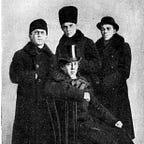Making a Mimicry of the Situation
Hundred thousandaires in the coupe to set the stage for
Scene set, play your role and bet your scene stretch
- Skyzoo
Studies have shown (I think; there’s like a 55% chance this shit is kinda accurate, like a 40% chance that it’s true) that humans that are able to communicate in social situations have an inclination to adopt the social groups vocabulary and accent. That’s it. The rest is 100% bullshit.
One significant point from this is that humans as individuals do not want to have this inclination. The inclination is organically expressed alongside our awareness of it. Our reaction to the inclination is entering the mind game territory so we won’t go there. Regardless, the inclination not being a want of our awareness means that the inclination can become unwanted.
We hear another person speak. Thus we are humans able to communicate in social situations. But we are put off by them. Maybe we’re xenophobic, maybe this other person is an asshole. The only certain thing is that we’re reacting against an internal inclination. We may associate/correlate our reaction against our inclination to the person speaking.
If we’re xenophobic, then the right thing to do would be to somehow supersede our own initial reaction against the inclination so that the inclination is wanted. For example, in the US, in some areas a white person that speaks American English may initiate to speak to a black person with badly spoken African American English. The white person may be trying to overcome their initial withdrawal from the conversation by Willing a want to adopt to this other person’s vocabulary and accent.
This other person, that happens to be black, may not understand what the white person said because the black person themselves had an inclination within them when the conversation began and the social structure formed by the white person’s words didn’t know how to react to the inclination.
You have two people coming together to create a social situation. It quickly becomes a study in behavioral psychology. With each person having enough self-awareness to identify the culprit as social conditioning, both people in the conversation stand in awkward silence. They know the conditioned awkwardness will shortly pass, their mind become clearer, and their heartbeat calmer.
The initial withdrawal from the white person was evident by their attempt to speak African American English. Their attempt to overcompensate required a Will. What resulted was a person that still had Will in them, but was now staring at a confused face.
The confused face talks back, “I’m assuming the intentions were good but no need to move away from your own vocabulary and accent.”
Both people continuously, organically are aware that themselves and each other have a concurrent process that is flowing, providing social norms; establishing an inclination settled by millions of years evolution to mimic/mirror an opposing appearance of consciousness.
The mimicry that we biologically reproduce is subtle but a keystone to any possibility of social communication. When we interact with a foreigner, we mimic them but we an awareness that we have difference meaning in what mimicry we expect in the other. When we interact with a possible enemy or valueless person, we have no understanding of the mimicry inside use, just an uneasiness.
This mimicry is aesthetically forged from social pressure but can be used by the individual for creativity / creating / reforming social norm / etc. Expressing yourself, walking to your own drum beat, etc.
After the clarification, the two people continue their conversation. Their language and accent start off with a certain distinction if the two people do have any differences. If the conversation goes on for long enough, the drift will the two people’s vocabulary and accent closer together without any input of want/unwant of awareness.
